Enhancing Load-Carrying Capacity of Reinforced Concrete Columns with High Aspect Ratio Using Textile-Reinforced Mortar Systems
Abstract
:1. Introduction
Columns with High Aspect Ratio
2. Preparation of Specimens and Application of TRM
2.1. Column Specimens
- (a)
- 263 mm × 75 mm × 700 mm—Aspect ratio: 3.50
- (b)
- 300 mm × 75 mm × 700 mm—Aspect ratio: 4.00
- (c)
- 325 mm × 75 mm × 700 mm—Aspect ratio: 4.33
- (d)
- 375 mm × 75 mm × 700 mm—Aspect ratio: 5.00
2.2. Materials
2.3. Method of Application
- The column surface was roughened to achieve a better bond between the mortar and column substrate.
- The column surface was pre-wetted with water, such that it was in a surface-saturated dry condition.
- A coat of SBR latex was applied on the roughened surface of the column, and the first layer of inorganic cementitious mortar was applied on it.
- When mortar was still fresh, the textile sheet was slightly pressed into mortar. Only one layer of the textile sheet was used in the current study, and an overlapping length of 75 mm was provided.
- This textile sheet was covered with a second layer of mortar and the outer surface was smoothened.
3. Experimental Setup
4. Results and Discussion
4.1. Load-Carrying Capacity of Columns and Aspect Ratio
4.2. Load–Axial Strain Response
4.3. Load–Displacement Response
4.4. Load–Strain Response
4.5. Failure Patterns
- Unconfined Columns
- Confined Columns
- -
- Visible Vertical Cracks on Outer Periphery
- -
- De-Bonding of Mortar Layer from Top
5. Conclusions
- The thickness of the mortar layers around the columns, particularly considering the reduction in the aspect ratios, played a crucial role. The analysis showed the strength improvements of 50% to 129% for the columns with the aspect ratios ranging from three to two, with the workmanship impacting the strength enhancement.
- A reduction in the aspect ratio from 5 to 4.16 and 3.24, respectively, resulted in an increase in the load-carrying capacity of up to 3.65% and 8.53%, respectively.
- In general, the unconfined columns indicated a reduced load-carrying capacity with higher displacements, whereas the strengthened columns displayed substantial capacity increments with less displacement. The 375-CC series illustrated minimal strength enhancement, closely aligning with the unconfined columns.
- 375-CC1, with a 16.8% reduction in the aspect ratio, presented a peak axial strain of 0.053 and a 3.65% increment in the peak load. The most noticeable increase in the peak strain values was observed in the 300 series, particularly for the CC2 column. 300-CC2, with a 65.75% reduction in the aspect ratio, depicted an 83.33% increase in the load-carrying capacity and a peak axial strain value of 0.04125.
- 263-CC2, which had the smallest aspect ratio, exhibited a peak lateral strain of 0.0061, whereas the unconfined 263-C had a peak lateral strain of 0.007. The reduction in the aspect ratio and the confinement by the TRM system reduced the lateral strain by 12.85%.
- The bonding of the TRM system with the substrate was a very important factor when considering the failure of the columns. The properties of the designed mortar, which affected the overall performance of the TRM system, were very important.
- The failure patterns of the unconfined and confined columns were distinct. The unconfined columns demonstrated a consistent failure pattern with cracks initiating from the edges and propagating vertically. The confined columns, under the influence of the TRM system, showed two failure patterns as visible vertical cracks on the outer periphery and de-bonding of the mortar layer from the top.
Author Contributions
Funding
Data Availability Statement
Conflicts of Interest
References
- Liao, H.; Ren, R.; Li, L. Existing Building Renovation: A Review of Barriers to Economic and Environmental Benefits. Int. J. Environ. Res. Public Health 2023, 20, 4058. [Google Scholar] [CrossRef] [PubMed]
- Ganesh, P.; Murthy, A.R. Repair, Retrofitting and Rehabilitation Techniques for Strengthening of Reinforced Concrete Beams—A Review. Adv. Concr. Constr. 2019, 8, 101–117. [Google Scholar] [CrossRef]
- Rajak, D.K.; Pagar, D.D.; Menezes, P.L.; Linul, E. Fiber-Reinforced Polymer Composites: Manufacturing, Properties, and Applications. Polymers 2019, 11, 1667. [Google Scholar] [CrossRef] [PubMed]
- Vivekanandan, R.; Aarthi, K. Behavior of Hybrid FRP Strengthened RC Column Under Axial Compression. Iran. J. Sci. Technol. Trans. Civ. Eng. 2023, 48, 1933–1945. [Google Scholar] [CrossRef]
- Shewale, M.; Murthi, P.; Chidambaram, S. Functional Performance of Textile Reinforced Mortar in Strengthening Structural Members: A Critical Review. AIP Conf. Proc. 2023, 2764, 50003. [Google Scholar]
- Shaikh, F.U.A.; Bamisile, O. Effect of High Temperatures on the Mechanical Properties of Fiber-Reinforced Cementitious Composites. J. Compos. Constr. 2023, 27, 4023011. [Google Scholar] [CrossRef]
- Veiga, M.R.; Magalhães, A.C.; Silva, C.; Silvestre, N. Durability of Textile Reinforced Mortars for the Reinforcement of Concrete Structures: Influence of Elevated Temperatures. Compos. Struct. 2020, 240, 112122. [Google Scholar] [CrossRef]
- Triantafillou, T. Textile-Reinforced Mortars (TRM). In Composite Materials; Nicolais, L., Meo, M., Milella, E., Eds.; Springer: London, UK, 2011. [Google Scholar] [CrossRef]
- Curbach, M.; Jesse, F. High-Performance Textile-Reinforced Concrete. Struct. Eng. Int. IABSE 1999, 4, 289–291. [Google Scholar] [CrossRef]
- Brameshuber, W.; Brockmann, J.; Roessler, G. Textile Reinforced Concrete for Formwork Elements—Investigations of Structural Behaviour. In Proceedings of the FRPRCS5, 5th International Conference on Fibre-Reinforced Plastics for Reinforced Concrete Structures, Cambridge, UK, 16–18 July 2001; pp. 1019–1026. [Google Scholar]
- Triantafillou, T.C.; Papanicolaou, C.G. Shear Strengthening of Reinforced Concrete Members with Textile Reinforced Mortar (TRM) Jackets. Mater. Struct. 2006, 39, 85–93. [Google Scholar]
- Triantafillou, T.C.; Papanicolaou, C.G.; Zissimopoulos, P.; Laourdekis, T. Concrete Confinement with Textile Reinforced Mortar (TRM) Jackets. ACI Struct. J. 2006, 103, 28–37. [Google Scholar]
- Bournas, D. Strengthening of Existing Structures: Selected Case Studies. In Textile Fibre Composites in Civil Engineering; Triantafillou, T.C., Ed.; Woodhead Publishing: Cambridge, UK, 2016; Chapter 17; pp. 389–411. [Google Scholar]
- Cascardi, A.; Longo, F.; Micelli, F.; Aiello, M.A. Compression Strength of Confined Columns with Fiber Reinforced Mortar (FRM): New Design-Oriented Models. Constr. Build. Mater. 2017, 156, 387–401. [Google Scholar] [CrossRef]
- Leone, M.; Aiello, M.A.; Balsamo, A.; Carozzi, F.G.; Ceroni, F.; Corradi, M.; Gams, M.; Garbin, E.; Gattesco, N.; Krajewski, P.; et al. Glass Fabric Reinforced Cementitious Matrix: Tensile Properties and Bond Performance on Masonry Substrate. Compos. Part B Eng. 2017, 127, 196–214. [Google Scholar] [CrossRef]
- Kariou, F.; Triantafyllou, S.; Bournas, D.A.; Koutas, L. Out-of-Plane Response of Masonry Walls Strengthened using Textile-Mortar System. Constr. Build. Mater. 2018, 165, 769–781. [Google Scholar] [CrossRef]
- Peled, A.; Bentur, A.; Mobasher, B. Textile Reinforced Concrete, 1st ed.; CRC Press: Boca Raton, FL, USA, 2017. [Google Scholar] [CrossRef]
- Brameshuber, W. Textile Reinforced Concrete: State of the Art Report; RILEM TC-201-TRC, Report 36; RILEM Publications: Aachen, Germany, 2006. [Google Scholar]
- De Felice, G.; De Santis, S.; Garmendia, L.; Ghiassi, B.; Larrinaga, P.; Lourenco, P.B.; Oliveira, D.V.; Paolacci, F.; Papanicolaou, C.G. Mortar-Based Systems for Externally Bonded Strengthening of Masonry. Mater. Struct. 2014, 47, 2021–2037. [Google Scholar] [CrossRef]
- De Santis, S.; de Felice, G. Steel Reinforced Grout Systems for the Strengthening of Masonry Structures. Compos. Struct. 2015, 134, 533–548. [Google Scholar] [CrossRef]
- Rampini, M.C.; Zani, G.; Colombo, M.; Di Prisco, M. Textile Reinforced Concrete Composites for Existing Structures: Performance Optimization via Mechanical Characterization. In Proceedings of the 12th Fib International PhD Symposium in Civil Engineering, Prague, Czech Republic, 29–31 August 2018; pp. 907–914. [Google Scholar]
- Koutas, L.N.; Tetta, Z.; Bournas, D.A.; Triantafillou, T.C. Strengthening of Concrete Structures with Textile Reinforced Mortars: State-of-the-Art Review. J. Compos. Constr. 2019, 23, 3118001. [Google Scholar] [CrossRef]
- Triantafillou, T.C.; Choutopoulou, E.; Fotaki, E.; Skorda, M.; Stathopoulou, M.; Karlos, K. FRP Confinement of Wall-Like Reinforced Concrete Columns. Mater. Struct. 2016, 49, 651–664. [Google Scholar] [CrossRef]
- Hosny, A.; Shahin, H.; Abdelrahman, A.; El-Afandy, T. Strengthening of Rectangular RC Columns using CFRP. In Proceedings of the 5th International Conference on Fibre-Reinforced Plastics for Reinforced Concrete Structures, Cambridge, UK, 16–18 July 2001; pp. 773–782. [Google Scholar]
- Tan, K.H. Strength Enhancement of Rectangular Reinforced Concrete Columns Using Fiber-Reinforced Polymer. J. Compos. Constr. 2002, 6, 175–183. [Google Scholar] [CrossRef]
- Tanwongsval, S.; Maalej, M.; Paramasivam, P. Strengthening of RC Wall-Like Columns with FRP under Sustained Loading. Mater. Struct. 2003, 36, 282–290. [Google Scholar] [CrossRef]
- Ombres, L. Confinement Effectiveness in Concrete Strengthened with Fiber Reinforced Cement Based Composite Jackets. In Proceedings of the FRPRCS-8, Patras, Greece, 16–18 July 2007. [Google Scholar]

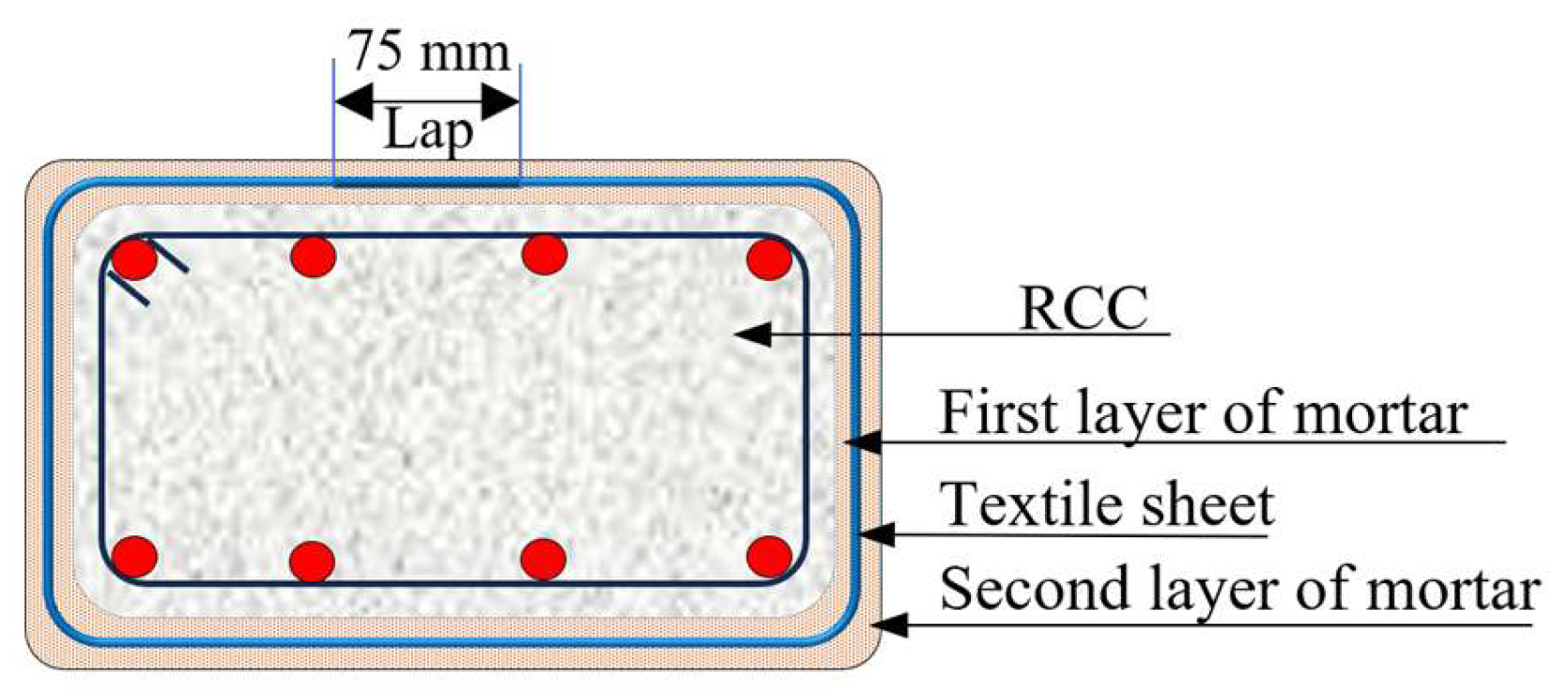
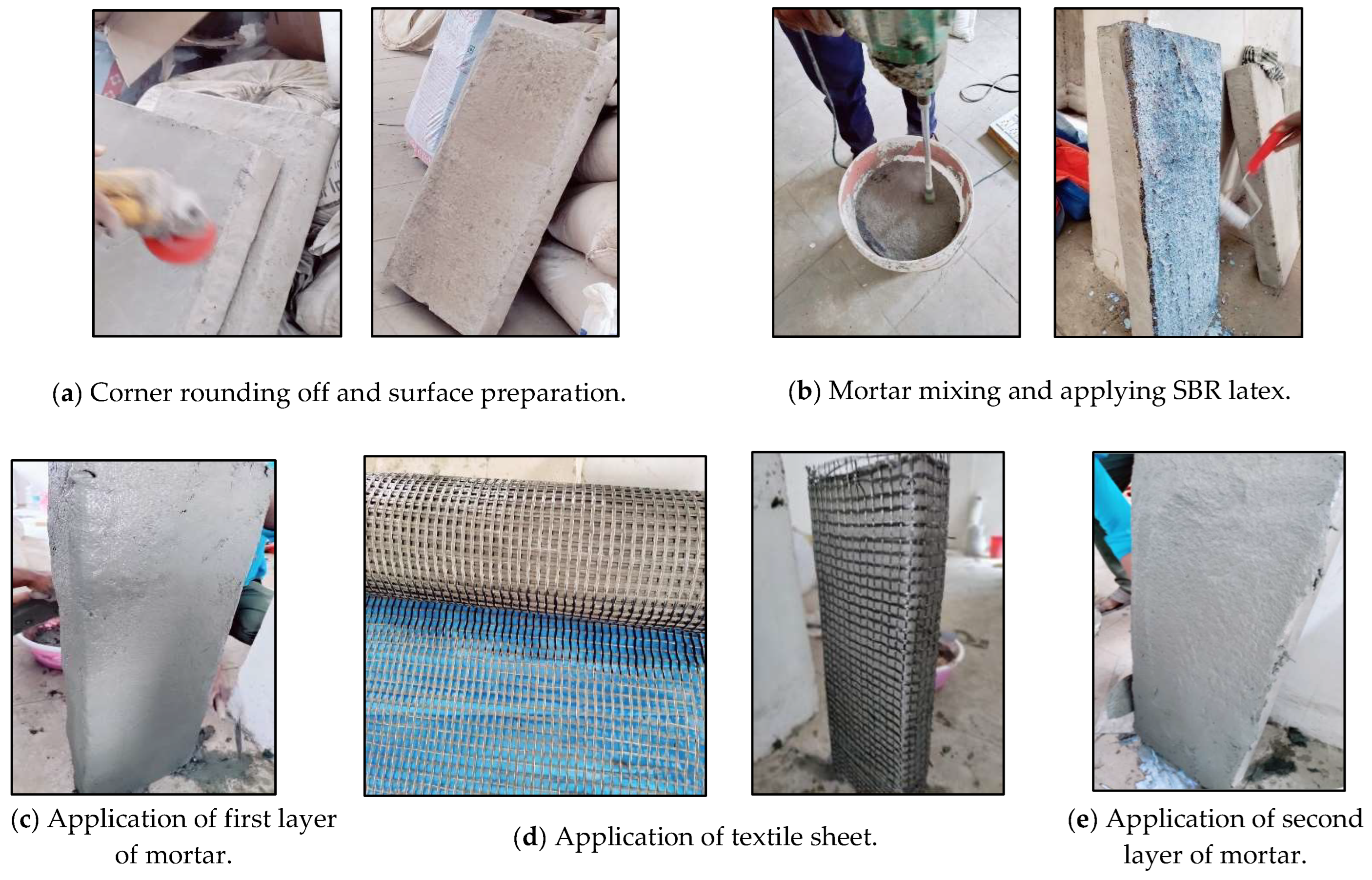
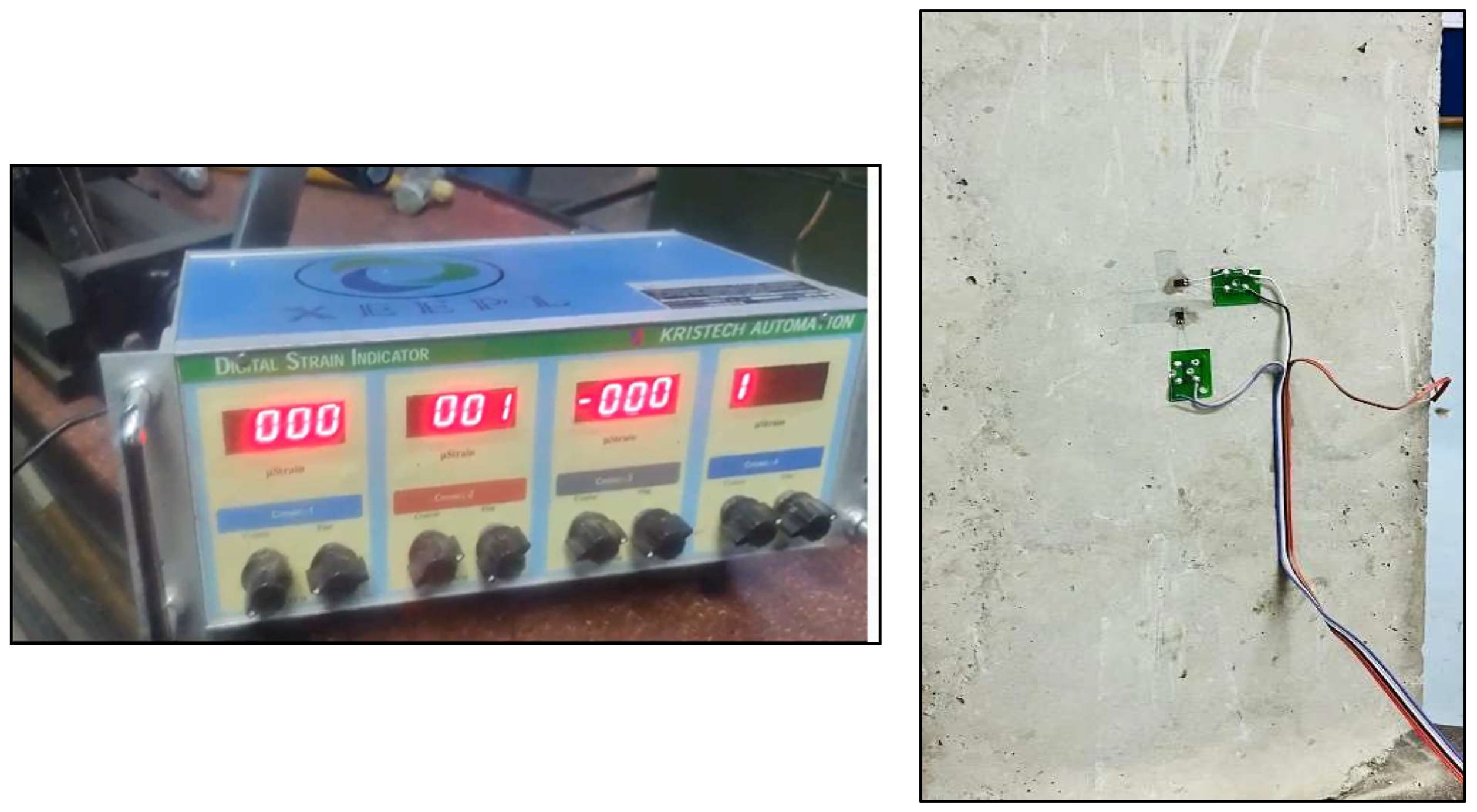
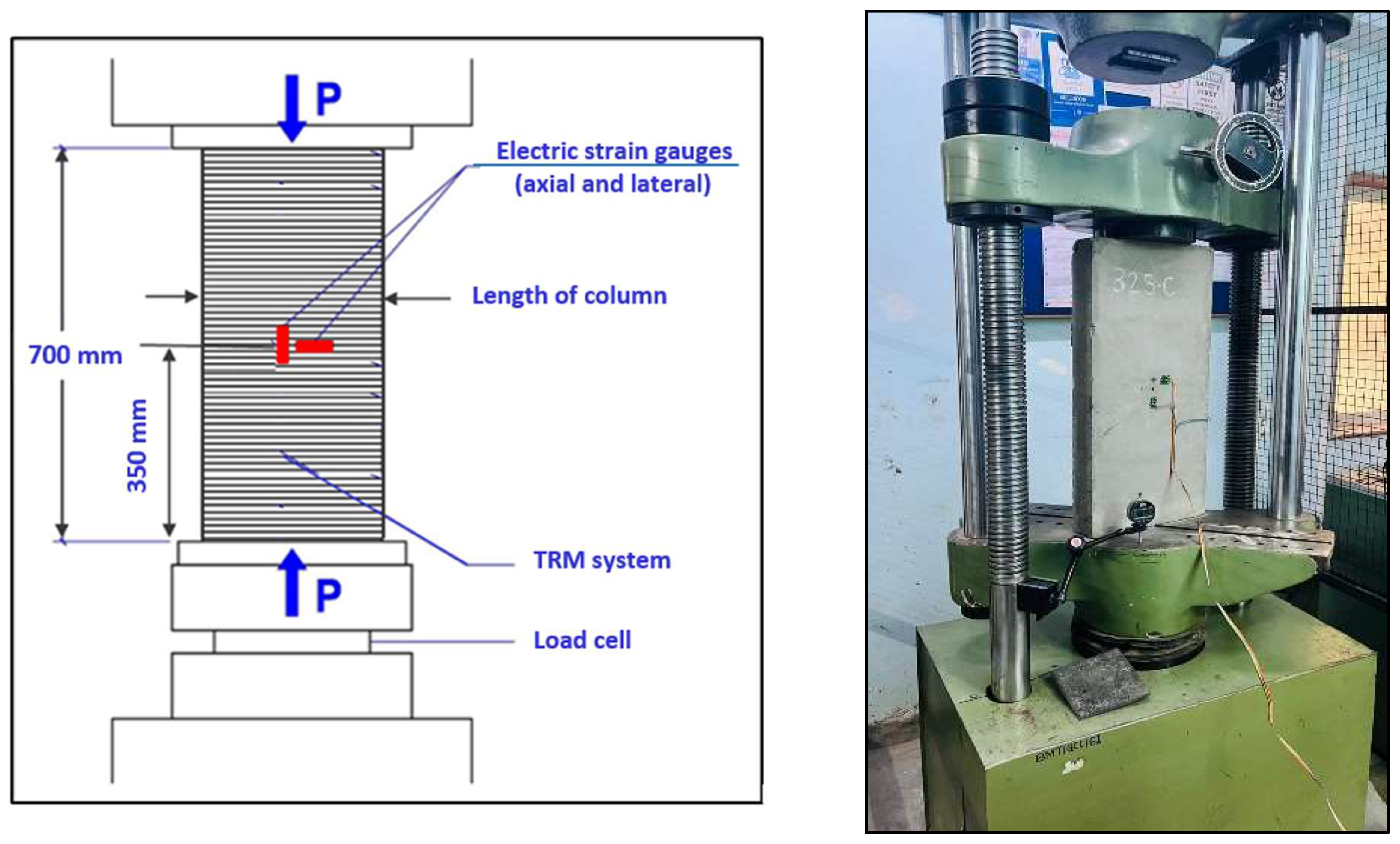

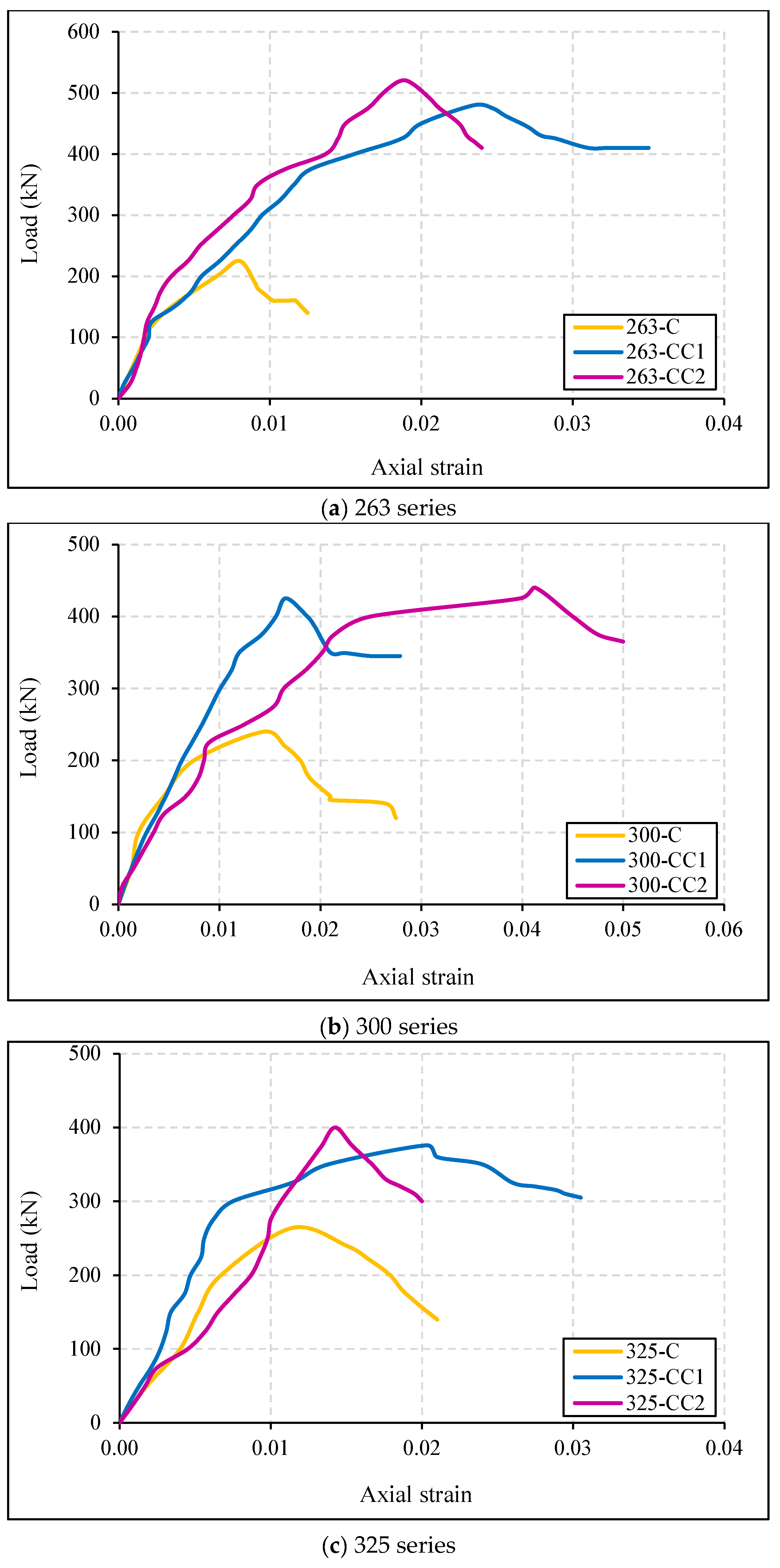
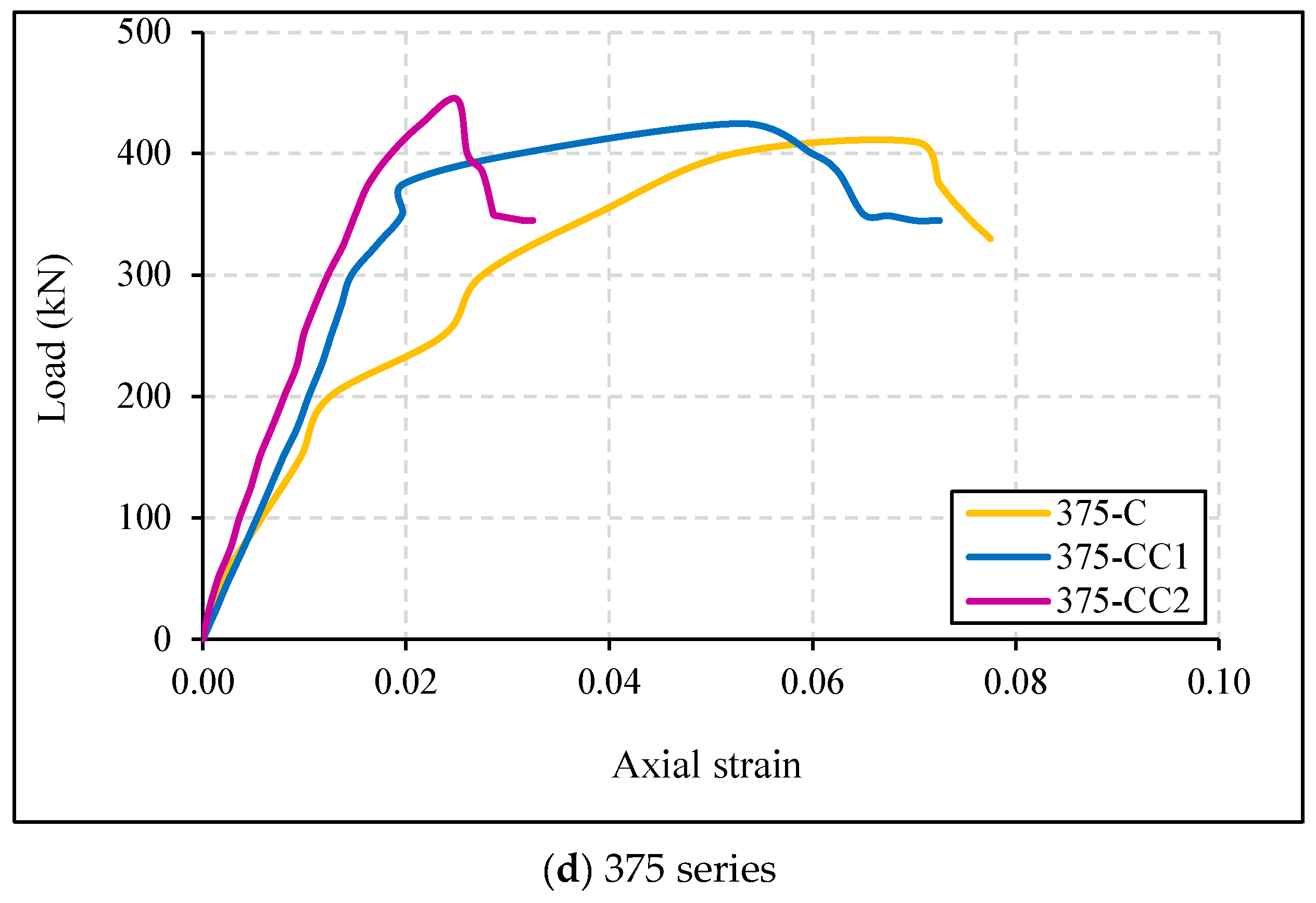
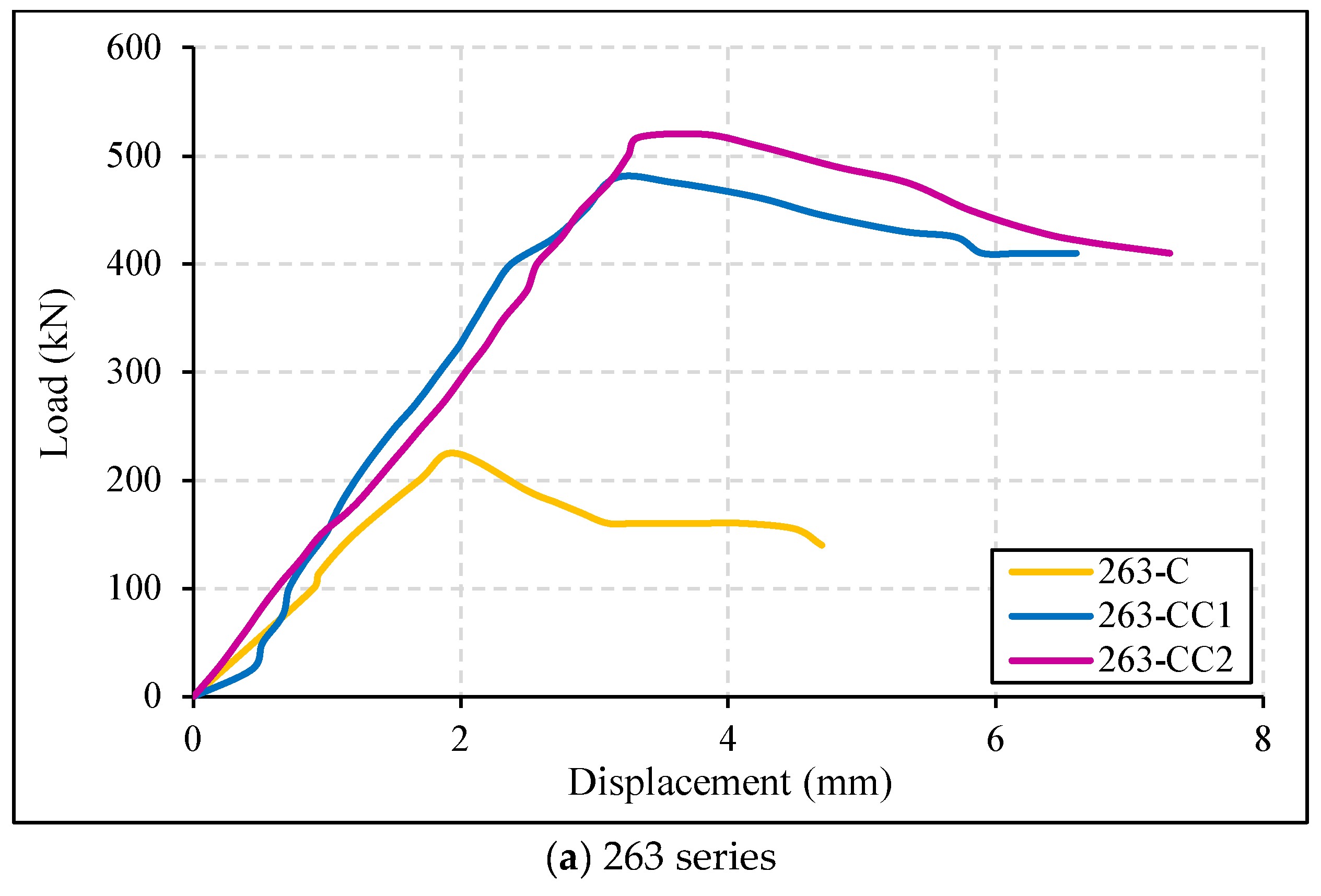
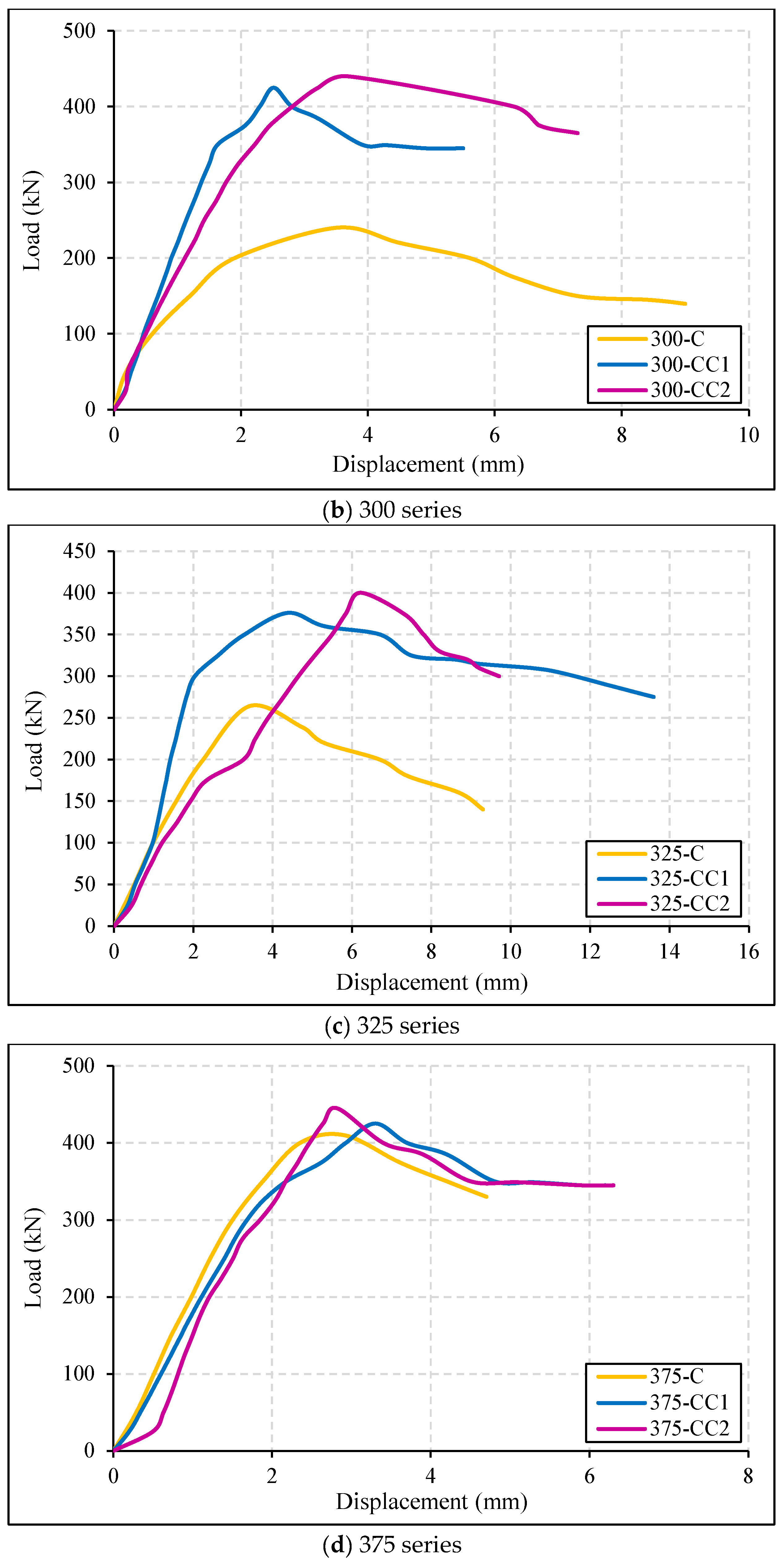
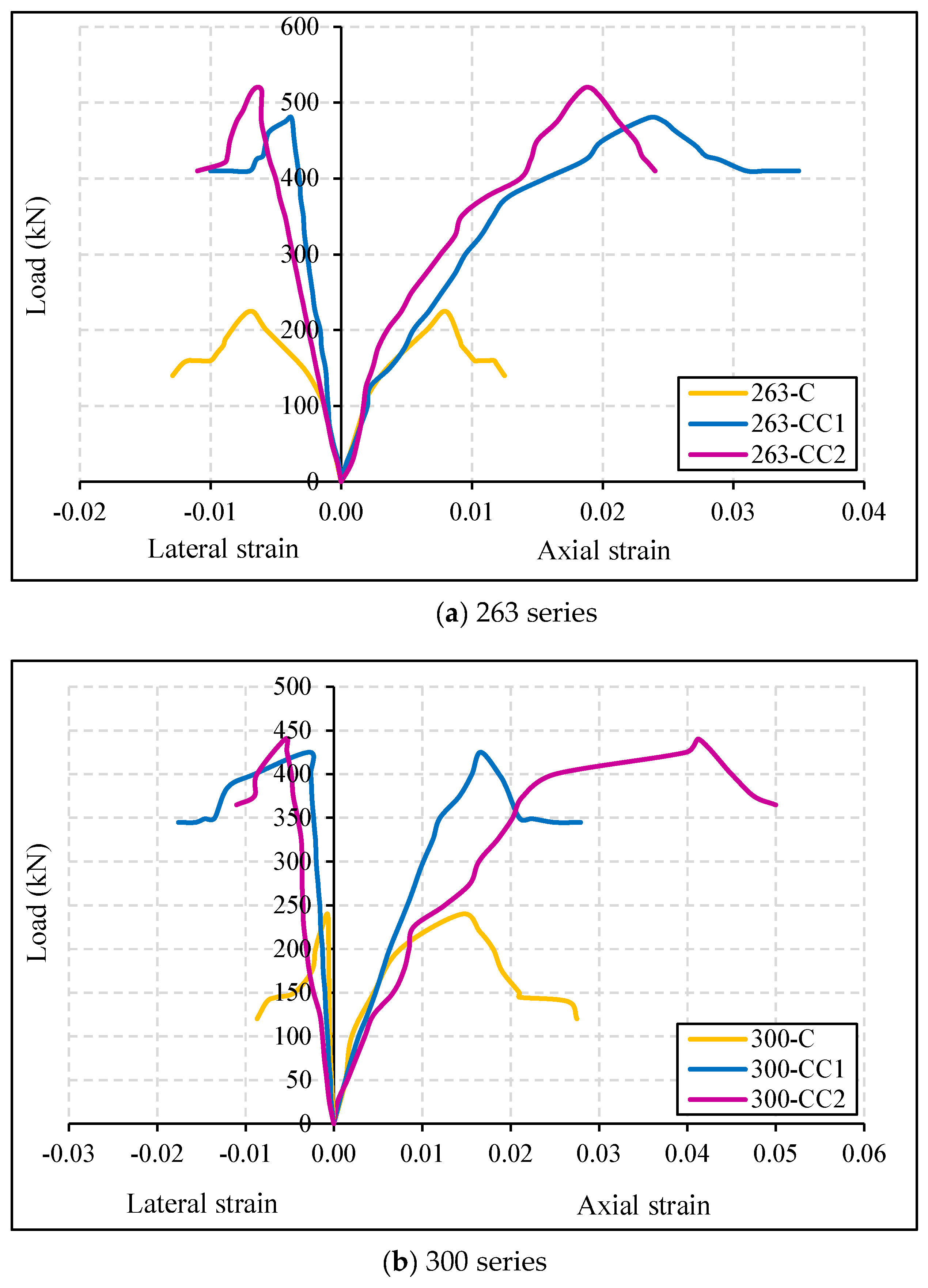
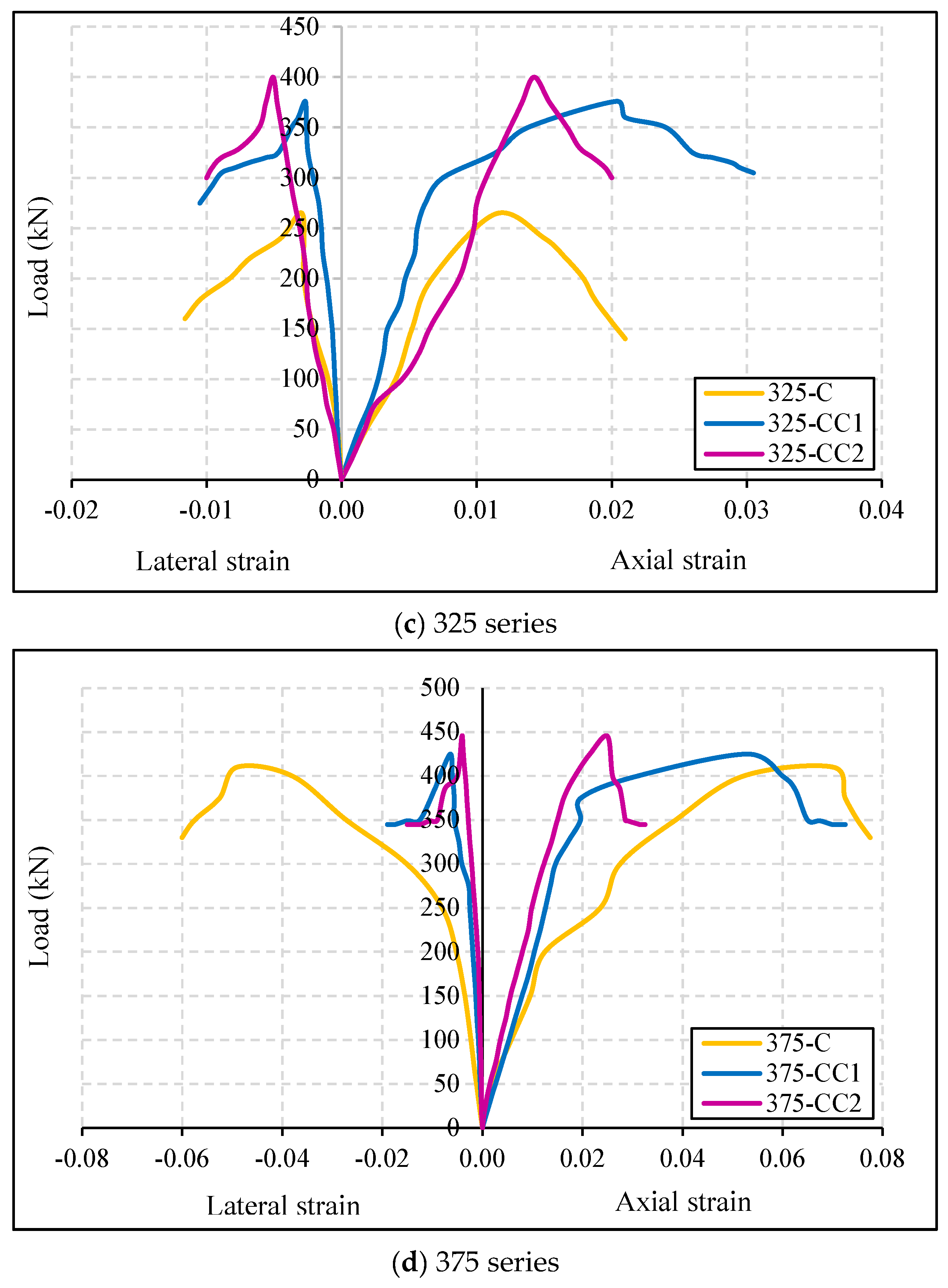

| Property | Value | Property | Value |
|---|---|---|---|
| Dry Fiber Property | Grid Property | ||
| Density filament | 1.8 g/cc | Grid size | 20 × 20 mm |
| Tensile strength | 4900 MPa | Aerial weight (GSM) | 250 g/m2 |
| Tensile modulus | 230 GPa | Ultimate tensile force | 150 kN/m |
| Elongation | 1.6% | Elastic modulus | 230 kN/mm2 |
| Diameter | 7 microns | - | - |
| Day | Compressive Strength (MPa) | Splitting Tensile Strength (MPa) | Flexural Strength (MPa) |
|---|---|---|---|
| 3 | 20.526 | 2.884 | 6.186 |
| 14 | 34.210 | 4.120 | 10.310 |
| 28 | 52.100 | 6.280 | 15.700 |
| Sr. No. | Test | Parameter | Result |
|---|---|---|---|
| 1 | Splitting bond test | Splitting bond strength ftb (MPa) | 2.10 |
| Effectiveness factor for splitting bond strength Rt | 70% | ||
| 2 | Slant shear test | Compressive strength (MPa) | 32.00 |
| Shear stress at failure τs (MPa) | 13.90 | ||
| Normal stress at failure σn (MPa) | 8.15 | ||
| Slant shear strength fsb (MPa) | 1.92 | ||
| 3 | Direct pull-off bond test | Direct pull-off bond strength fab (MPa) | 7.17 |
| 4 | Pull-out test (textile and mortar bond) | Pull-out bond strength fpb (MPa) | 6.00 |
| Sr. No. | Designation of Specimen | Size of Unconfined Column (b × h × L) (mm) | Thickness of First Layer of Mortar (mm) | Thickness of Second Layer of Mortar (mm) | Final Cross-Sectional Size of Column (b × h) (mm) | Aspect Ratio |
|---|---|---|---|---|---|---|
| 1 | 263-C | 263 × 75 × 700 | Unconfined | 263 × 75 | 3.50 | |
| 2 | 263-CC1 | 5 mm all around | 283 × 95 | 2.97 | ||
| 3 | 263-CC2 | 6 mm for longer side 12 mm for shorter side | 287 × 123 | 2.33 | ||
| 4 | 300-C | 300 × 75 × 700 | Unconfined | 300 × 75 | 4.00 | |
| 5 | 300-CC1 | 12 mm all around | 348 × 123 | 2.83 | ||
| 6 | 300-CC2 | 6 mm for longer side 12 mm for shorter side | 324 × 123 | 2.63 | ||
| 7 | 325-C | 325 × 75 × 700 | Unconfined | 325 × 75 | 4.33 | |
| 8 | 325-CC1 | 12 mm all around | 375 × 123 | 3.05 | ||
| 9 | 325-CC2 | 6 mm for longer side 12 mm for shorter side | 349 × 123 | 2.84 | ||
| 10 | 375-C | 375 × 75 × 700 | Unconfined | 375 × 75 | 5.00 | |
| 11 | 375-CC1 | 5 mm all around | 395 × 95 | 4.16 | ||
| 12 | 375-CC2 | 6 mm for longer side 12 mm for shorter side | 399 × 123 | 3.24 | ||
| Sr. No. | Designation of Specimen | Final Cross-Sectional Size of Column (b × h) (mm) | Aspect Ratio | Peak Compression Load (kN) |
|---|---|---|---|---|
| 1 | 263-C | 263 × 75 | 3.50 | 225 |
| 2 | 300-C | 300 × 75 | 4.00 | 240 |
| 3 | 325-C | 325 × 75 | 4.33 | 264 |
| 4 | 375-C | 375 × 75 | 5.00 | 410 |
| 5 | 263-CC1 | 283 × 95 | 2.97 | 480 |
| 6 | 263-CC2 | 287 × 123 | 2.33 | 517 |
| 7 | 300-CC1 | 348 × 123 | 2.83 | 425 |
| 8 | 300-CC2 | 324 × 123 | 2.63 | 440 |
| 9 | 325-CC1 | 375 × 123 | 3.05 | 376 |
| 10 | 325-CC2 | 349 × 123 | 2.84 | 400 |
| 11 | 375-CC1 | 395 × 95 | 4.16 | 425 |
| 12 | 375-CC2 | 399 × 123 | 3.24 | 445 |
Disclaimer/Publisher’s Note: The statements, opinions and data contained in all publications are solely those of the individual author(s) and contributor(s) and not of MDPI and/or the editor(s). MDPI and/or the editor(s) disclaim responsibility for any injury to people or property resulting from any ideas, methods, instructions or products referred to in the content. |
© 2024 by the authors. Licensee MDPI, Basel, Switzerland. This article is an open access article distributed under the terms and conditions of the Creative Commons Attribution (CC BY) license (https://creativecommons.org/licenses/by/4.0/).
Share and Cite
Shewale, M.; Bahrami, A.; Murthi, P.; Chidambaram, R.S. Enhancing Load-Carrying Capacity of Reinforced Concrete Columns with High Aspect Ratio Using Textile-Reinforced Mortar Systems. Buildings 2024, 14, 2050. https://doi.org/10.3390/buildings14072050
Shewale M, Bahrami A, Murthi P, Chidambaram RS. Enhancing Load-Carrying Capacity of Reinforced Concrete Columns with High Aspect Ratio Using Textile-Reinforced Mortar Systems. Buildings. 2024; 14(7):2050. https://doi.org/10.3390/buildings14072050
Chicago/Turabian StyleShewale, Manisha, Alireza Bahrami, P. Murthi, and R. Siva Chidambaram. 2024. "Enhancing Load-Carrying Capacity of Reinforced Concrete Columns with High Aspect Ratio Using Textile-Reinforced Mortar Systems" Buildings 14, no. 7: 2050. https://doi.org/10.3390/buildings14072050
APA StyleShewale, M., Bahrami, A., Murthi, P., & Chidambaram, R. S. (2024). Enhancing Load-Carrying Capacity of Reinforced Concrete Columns with High Aspect Ratio Using Textile-Reinforced Mortar Systems. Buildings, 14(7), 2050. https://doi.org/10.3390/buildings14072050







